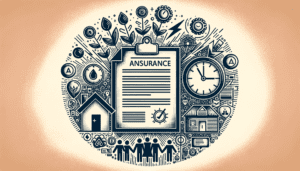Should my life insurance coverage be more than my total debt?

Life insurance is a crucial aspect of financial planning that provides an essential safety net for your loved ones in the event of your untimely death. One common question that often arises when considering life insurance is whether your coverage should be more than your total debt. To answer this question, it is important to understand the basics of life insurance and the role that debt plays in your overall financial picture.
Understanding the Basics of Life Insurance
Life insurance is a contract between you and an insurance company that provides a lump-sum payment, known as a death benefit, to your beneficiaries upon your death. This financial protection can help replace your income, cover funeral expenses, pay off debts, and ensure your loved ones’ financial well-being.
Life insurance is an essential part of financial planning for individuals and families. It offers a sense of security and peace of mind, knowing that your loved ones will be taken care of financially in the event of your passing. But how exactly does life insurance work? What are the different types of life insurance policies available? Let’s delve deeper into the world of life insurance to gain a better understanding.
What is Life Insurance?
Life insurance is designed to offer financial security and peace of mind to those who depend on you financially. It acts as a financial safety net to replace the lost income and support your loved ones need to maintain their quality of life. The death benefit provided by a life insurance policy can be used to cover various expenses, including mortgage payments, college tuition, and everyday living expenses.
Life insurance policies come in different forms, each with its own set of features and benefits. The two main categories of life insurance are term life insurance and permanent life insurance. Term life insurance provides coverage for a specified period, typically 10, 20, or 30 years, while permanent life insurance offers coverage for your entire life.
Types of Life Insurance
There are various types of life insurance policies available, including term life insurance, whole life insurance, and universal life insurance. Term life insurance provides coverage for a specified period, usually ranging from 10 to 30 years. It is often the most affordable option and is suitable for individuals who need coverage for a specific period, such as until their children are grown or their mortgage is paid off.
Whole life insurance, on the other hand, offers coverage for your entire life. It not only provides a death benefit but also accumulates cash value over time. This cash value can be accessed during your lifetime through policy loans or withdrawals, providing a source of funds for emergencies or other financial needs.
Universal life insurance is a flexible type of permanent life insurance that allows you to adjust your premium payments and death benefit amount as your needs change. It offers the potential for cash value growth, similar to whole life insurance, but with more flexibility in managing your policy.
How Does Life Insurance Work?
When you purchase a life insurance policy, you pay regular premiums to the insurance company. In return, the insurance company promises to pay out a death benefit to your beneficiaries when you pass away, as long as the policy is in force at the time of your death. The death benefit can be a significant amount of money, providing financial security for your loved ones during a difficult time.
Life insurance policies also come with certain features and options that you can customize to suit your needs. For example, you can choose to add riders to your policy, such as a critical illness rider or an accidental death benefit rider, to enhance your coverage. Riders provide additional benefits beyond the basic death benefit, giving you added protection and peace of mind.
It’s important to review your life insurance needs periodically to ensure that your coverage aligns with your current financial situation and goals. As your life circumstances change, such as getting married, having children, or buying a home, you may need to adjust your life insurance coverage to provide adequate protection for your loved ones.
In conclusion, life insurance is a vital component of a well-rounded financial plan. It offers financial security and peace of mind, knowing that your loved ones will be taken care of financially in the event of your passing. Understanding the different types of life insurance policies available and how they work can help you make informed decisions when it comes to protecting your family’s future.
Enter your ZIP code below to compare cheap life insurance rates.
Secured with SHA-256 Encryption
The Role of Debt in Your Financial Picture
Debt is a common aspect of many people’s financial lives. It can take various forms, such as mortgages, car loans, student loans, and credit card debt. Understanding the impact of debt on your overall financial health is essential when considering the appropriate amount of life insurance coverage to have.
When it comes to debt, it’s important to have a clear understanding of the different types that exist. There are two primary types of debt: secured and unsecured debt. Secured debt is backed by collateral, such as your home or car. This means that if you fail to make payments, the lender has the right to repossess the collateral to recover their money. On the other hand, unsecured debt, like credit card debt, doesn’t have any collateral attached. This means that if you default on your payments, the lender doesn’t have a specific asset to seize.
The impact of debt on your financial health can be significant. Having debt can limit your financial flexibility and affect your ability to save for the future. When you have debt obligations, a portion of your income goes towards repaying those debts, leaving you with less money to allocate towards other financial goals, such as saving for retirement or emergencies.
Furthermore, debt can also affect your credit score. Your credit score is a measure of your creditworthiness and is used by lenders to determine whether to approve your loan applications and what interest rate to offer you. High levels of debt and missed payments can negatively impact your credit score, making it more difficult for you to access credit in the future and potentially leading to higher interest rates on any loans you do obtain.
When it comes to life insurance, it’s important to consider your outstanding debts when determining your coverage needs. If you were to pass away unexpectedly, your debts would not disappear. They would become the responsibility of your loved ones or your estate. By having adequate life insurance coverage, you can ensure that your family is not burdened with your debt obligations, allowing them to maintain their financial stability during a difficult time.
In conclusion, debt plays a significant role in your overall financial picture. It can impact your financial flexibility, creditworthiness, and ability to save for the future. When considering life insurance, it’s crucial to take into account your outstanding debts to ensure that your loved ones are not left with a financial burden in the event of your passing.
Determining Your Life Insurance Needs
Several factors come into play when determining the appropriate amount of life insurance coverage you should have. It is essential to take these factors into account to ensure that your loved ones are adequately protected.
Life insurance is a crucial financial tool that provides financial security and peace of mind for your family in the event of your untimely death. By assessing your specific circumstances and considering various factors, you can determine the ideal coverage amount that will meet your family’s needs.
Factors to Consider When Choosing Life Insurance Coverage
When choosing life insurance coverage, consider factors such as your income, outstanding debts, mortgage, education expenses, and your family’s future financial needs. Each individual’s situation is unique, so it’s important to assess your specific circumstances to determine the appropriate coverage amount.
Your income plays a significant role in determining your life insurance needs. If you are the primary breadwinner, your policy should aim to replace a portion of your income to ensure that your family can maintain their current standard of living. Additionally, consider any outstanding debts you may have, such as credit card debt, student loans, or a mortgage. Life insurance can help cover these financial obligations, preventing your loved ones from being burdened with them.
Education expenses are another critical factor to consider. If you have children, you may want to factor in the cost of their education, including tuition fees, books, and other related expenses. By including these costs in your life insurance coverage, you can ensure that your children’s educational needs are met, regardless of your absence.
Furthermore, it’s essential to consider your family’s future financial needs. This includes day-to-day living expenses, medical bills, and any other financial obligations that may arise. By carefully evaluating these factors, you can determine the appropriate coverage amount that will provide your family with the necessary financial support.
Calculating Your Life Insurance Needs
There are different methods you can use to calculate your life insurance needs, such as the DIME method (Debts, Income, Mortgage, Education) or the Human Life Value approach. These methods take into account your current financial obligations, future expenses, and potential income replacement.
The DIME method involves assessing your outstanding debts, including loans, credit card balances, and any other financial obligations. It also considers your income and the number of years your loved ones would need financial support. Additionally, the DIME method takes into account your mortgage, ensuring that your family can continue living in their current home without the burden of mortgage payments.
The Human Life Value approach, on the other hand, focuses on your potential income replacement. It considers your current income, future earning potential, and the number of years your loved ones would require financial support. By calculating the present value of your future income, you can determine the appropriate life insurance coverage needed to replace your income and provide for your family’s financial well-being.
Ultimately, the method you choose to calculate your life insurance needs will depend on your specific circumstances and preferences. Consulting with a financial advisor or insurance professional can help you navigate through the various options and determine the most suitable approach for your situation.
The Relationship Between Life Insurance and Debt
When it comes to life insurance coverage, the question arises whether your coverage should exceed your total debt. While there is no one-size-fits-all answer, it is worth considering the pros and cons to make an informed decision.
Should Life Insurance Cover Your Debt?
Having life insurance coverage that exceeds your total debt can provide additional financial security for your loved ones. It ensures that your family receives a sufficient payout to cover not only your outstanding debts but also other financial obligations they may have.
Pros and Cons of Having Life Insurance Coverage Exceeding Your Debt
One advantage of having life insurance coverage exceeding your debt is that it provides a more comprehensive financial safety net for your loved ones. They can have the means to maintain their standard of living, cover ongoing expenses, and achieve future financial goals.
On the other hand, some may argue that having excessive life insurance coverage can be unnecessary and lead to higher premiums. It is crucial to assess your specific financial situation and comfort level to strike the right balance between coverage and affordability.
Enter your ZIP code below to compare cheap life insurance rates.
Secured with SHA-256 Encryption
Case Studies: Life Insurance Coverage and Debt
Examining real-life case studies can provide valuable insights into the relationship between life insurance coverage and debt. Let’s explore two hypothetical scenarios:
Case Study 1: High Debt, Low Coverage
In this scenario, an individual has significant debt, including a mortgage, student loans, and credit card debt. However, their life insurance coverage is minimal, only covering a fraction of their outstanding obligations. In the event of their passing, their family may face financial hardship, struggling to pay off the debt and maintain their quality of life.
Case Study 2: Low Debt, High Coverage
In contrast, this case study features an individual with minimal debt, having paid off their mortgage and other outstanding obligations. Despite the low amount of debt, they carry substantial life insurance coverage. This ensures that their loved ones are well-protected, with the potential to use the excess funds to invest, save for the future, or fulfill other financial goals.
In Conclusion
When considering life insurance coverage, it is crucial to evaluate your total debt and financial situation. While having life insurance coverage exceeding your debt can provide additional peace of mind, it’s essential to find the right balance. Assessing your specific needs and considering various factors will help you make an informed decision to provide financial security for your loved ones.
Frequently Asked Questions
What is the significance of having life insurance coverage?
Life insurance coverage provides financial protection for your loved ones in the event of your death. It ensures that they are not burdened with your debts and can maintain their standard of living.
Should my life insurance coverage be more than my total debt?
It is generally recommended to have life insurance coverage that is sufficient to cover your total debt and provide additional funds to support your family’s needs. However, the ideal coverage amount depends on various factors such as your income, dependents, and future financial goals.
What factors should I consider when determining the appropriate life insurance coverage amount?
When determining the appropriate life insurance coverage amount, consider factors such as your outstanding debts, mortgage or rent payments, future education expenses for your children, daily living expenses, and any other financial obligations your family may have.
Can life insurance coverage be used to pay off my debts?
Yes, life insurance coverage can be used to pay off your debts. If you pass away and have sufficient coverage, the insurance proceeds can be used to settle your outstanding debts, relieving your family from the financial burden.
What happens if my life insurance coverage is less than my total debt?
If your life insurance coverage is less than your total debt, your beneficiaries may be responsible for settling the remaining debt. It is important to regularly review and update your life insurance coverage to ensure it adequately addresses your financial obligations.
How can I determine the appropriate life insurance coverage amount?
Determining the appropriate life insurance coverage amount can be done by assessing your current and future financial needs. Consider consulting with a financial advisor or insurance professional who can help evaluate your specific circumstances and guide you in selecting the right coverage amount.
Enter your ZIP code below to compare cheap life insurance rates.
Jeffrey Johnson
Insurance Lawyer
Jeffrey Johnson is a legal writer with a focus on personal injury. He has worked on personal injury and sovereign immunity litigation in addition to experience in family, estate, and criminal law. He earned a J.D. from the University of Baltimore and has worked in legal offices and non-profits in Maryland, Texas, and North Carolina.
He has also earned an MFA in screenwriting from Chapman Univer…
Benjamin Carr
Former State Farm Insurance Agent
Benjamin Carr worked as a licensed insurance agent at State Farm and Tennant Special Risk. He sold various lines of coverage and informed his clients about their life, health, property/casualty insurance needs.
Assessing risks and helping people find the best coverage to suit their needs is a passion of his. He appreciates that insurance was designed to protect people, particularly during times…
Former State Farm Insurance Agent
Editorial Guidelines: We are a free online resource for anyone interested in learning more about life insurance. Our goal is to be an objective, third-party resource for everything life insurance-related. We update our site regularly, and all content is reviewed by life insurance experts.






